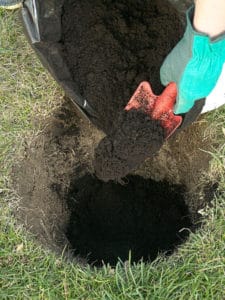Q: How much should a perc test cost? I live in Pennsylvania and the septic company I hired is demanding $2,400 for a perc test. They say that the test itself (3 feet) will cost $650, a soil scientist will cost $500, excavator and operator is $750, and a drip system design is $1,400. Does this sound about right or am I being taken advantage of? Please help – Minji
A: Perc test costs can range widely from as little as $300 to $1,200 or more depending on local regulations and site conditions. Testing can range from dumping a bucket a water into two or three hand-dug holes to digging multiple deep pits with an excavator with testing overseen by an engineer. Costs will vary accordingly.
A full-scale perc test, combined with a deep-hole test, that is conducted by an engineer or licensed soil scientist, often costs several hundred dollars – sometimes $1,200 or more depending on local regulations, site conditions, and regional labor costs. Figure around $200/hr. for an engineer and $100 per hour for a backhoe and operator. It adds up quickly.

At the low end of the range, a perc test done by a septic contractor with a hand auger and shovel, without an engineer involved, can cost as little as $300 or $400. Towns often require two to four test holes.
If you subtract out the $1,400 you were quoted as design costs, your perc test is costing you $1,000. That is at the high end, but not out of line for a site that requires both a perc test and deep-hole test. In addition to the perc testing costs of $400 to $1,200, you can expect system design and permitting fees ranging from $500 to $1,200 – or more to design an alternative septic system.
Cost Factors in Perc Test
Soil testing is completed to see if a building site is suitable for on-site sewage treatment and also to enable the designer to specify the type of system and drain field area. The term “perc” or “perk” test is often used to refer to both the perc test to measure the soil’s rate of water absorption and a deep hole test to visually examine the soil layers. Key issues are the depth of the water table and impermeable soil layers such as rock or hardpan.
Most jurisdictions now require a deep hole test which means you will need at least a small excavator. On a large lot, you may need to explore multiple sites to find one that is suitable for a septic system. For example, you may be looking for a spot with well-drained soil, or adequate distance to subsurface water, rock, or hardpan.
The biggest drivers of costs are the rules put in place by the local health department. They determine what tests are required, who can perform the test, test procedures and protocols, and how many test holes are required. Also, don’t forget the town fee, which can range from $50 to $500 or more in towns that require a town official to witness the test.
Costs will be highest under when:
- A licensed engineer or soil scientist must be present.
- Excavation equipment is needed.
- Multiple test pits are required.
- Site access is limited or steep.
- Difficult soils are encountered – wet, rocky, or dense soils
- You live in an a highly regulated area with high building costs.
Cost Controls
Excavation expenses can drive up costs quickly at $75 to $150 per hour. The smaller the equipment you can use, the lower your hourly rate will be. You may also be able to save by hiring a septic contractor, rather than an engineer to conduct your test, if allowed. Some jurisdictions allow owners to perform their own tests.
Regulations will be more strict and costs will be generally be higher in metro areas or regions with generally high construction costs. This includes the Northeast, Northwest, and West Coast. Of course, there’s not much you can do about that.
It sounds like your cost estimate includes the price of designing a “drip irrigation” system, a type of alternative septic system. I’m not sure how they can know that an alternative system is required before testing. It’s possible that you are building in an area where most sites require an alternative septic system and they are making that assumption in your price estimate. Get clarification on this point. Alternative systems cost 2-3 times as much as conventional systems and require much greater monitoring and maintenance.
Finally, it never hurts to get a second cost estimate. You may find out that the first price was a good deal – or you may save a few hundred dollars with the second bid. Either way, this provides some peace of mind. – Steve Bliss, Editor, BuildingAdvisor.com
See Also:
Are Alternative Systems Allowed?
Chamber System Failure
How Much Slope For Septic Line?
Inspecting a Septic System
Lifespan of Septic System’
Minimum Lot Size For Septic System
Perc Test Cost
Perc Test: Best Time of Year?
Replacing Failed Drain Field in Same Location
Retesting a Site That Failed to Perc
Sand Filter for Existing System
Testing an Existing Septic System
Testing for a New Septic System
Wet Sites, Septic Systems For
Who Performs Perc Test?
View all SEPTIC SYSTEM articles
Leave a Reply